Investigation on Single Tube CFST Arch Models by Modeling Structural Stressing State Based on NSF Method
Abstract
:1. Introduction
2. Introduction of Analysis Methods
2.1. Method of Numerical Shape Function
2.2. Method of Modeling Structural Stressing State
3. Introduction of the Experiments
3.1. Experiment on CFST Arches under In-Plane Loads
3.2. Experiment on the CFST Arch under Spatial Loads
4. Interpolation of Experimental Data by NSF Method
4.1. Accuracy Evaluation of NSF Method
4.2. Interpolation on Strains and Stress
5. Stressing State Analysis of CFST Arch Models
5.1. Investigation into Parameter SED for Modeling Structural Stressing State
5.2. Investigation into Measured Strains of Two Arch Models
5.3. Change Characteristics Reflected by Strain/Stress Fields of Arch Models
5.4. Investigation into Structural Stressing State Submodes on Internal Forces
6. Conclusions
Author Contributions
Funding
Acknowledgments
Conflicts of Interest
References
- Chen, B.C. Recent development and future trends of arch bridges. In Proceedings of the 7th International Conference on Arch Bridges, Trogir-Split, Croatia, 4–6 October 2013. [Google Scholar]
- Zhong, S.T. The Concrete-Filled Steel Tubular Structures; Tsinghua University Press Publishers: Beijing, China, 2003. [Google Scholar]
- Han, L.H. The influence of concrete compaction on the strength of concrete filled steel tubes. Adv. Struct. Eng. 2000, 3, 131–137. [Google Scholar] [CrossRef]
- Chen, B.C. An overview of concrete and CFST arch bridges in China. In Proceedings of the 5th International Conference on Arch Bridges, Madeira, Portugal, 12–14 September 2007. [Google Scholar]
- Zheng, J.; Wang, J. Concrete-filled steel tube arch bridges in China. Engineering 2018, 4, 143–155. [Google Scholar] [CrossRef]
- Pi, Y.L.; Trahair, N.S. In-plane buckling and design of steel arches. J. Struct. Eng. 1999, 125, 1291–1298. [Google Scholar] [CrossRef]
- Pi, Y.L.; Liu, C.; Bradford, M.A.; Zhang, S. In-plane strength of concrete-filled steel tubular circular arches. J. Constr. Steel. Res. 2012, 69, 77–94. [Google Scholar] [CrossRef]
- Cheng, X.L. In-plane Stability Parabolic Concrete-Filled Steel Tubular Arches with Low Rise-Span Ratios. Master’s Thesis, Harbin Institute of Technology, Harbin, China, 2014. (In Chinese). [Google Scholar]
- Li, Z.L.; Zhou, P.Y. Research on overall stability of concrete-filled steel tubular bowstring arch bridge. Adv. Struct. Eng. 2011, 243–249, 1988–1994. [Google Scholar] [CrossRef]
- Yu, H.G.; Zhou, S.X.; Chen, Q.; Hu, X.L. Influence of initial stress on concrete-filled steel tubular arch bridge stability and bearing capacity. J. Changsha Univ. Sci. Technol. Nat. Sci. 2005, 2, 18–22. (In Chinese) [Google Scholar]
- Pi, Y.L.; Trahair, N.S. Non-linear buckling and postbuckling of elastic arches. Eng. Struct. 1998, 20, 571–579. [Google Scholar] [CrossRef]
- Geng, Y.; Wang, Y.; Ranzi, G.; Wu, X. Time-dependent analysis of long-span, concrete-filled steel tubular arch bridges. J. Bridge Eng. 2014, 19, 04013019. [Google Scholar] [CrossRef]
- Luo, K.; Pi, Y.L.; Gao, W.; Bradford, M.A.; Hui, D. Investigation into long-term behaviour and stability of concrete-filled steel tubular arches. J. Constr. Steel Res. 2015, 104, 127–136. [Google Scholar] [CrossRef]
- Chen, B.C.; Chen, Y.J. Experimental study on mechanic behaviors of concrete-filled steel tubular rib arch under in-plane loads. Eng. Mech. 2000, 17, 44–50. [Google Scholar] [CrossRef]
- Liu, Y.; Wang, D.; Zhu, Y.Z. Analysis of ultimate load-bearing capacity of long-span CFST arch bridges. Appl. Mech. Mater. 2011, 90–93, 1149–1156. [Google Scholar] [CrossRef]
- Han, X.; Zhu, B.; Liu, G.M.; Wang, J.P.; Xiang, B.S. The analysis of double-nonlinearity stability of concrete filled steel-tube arch bridge. Adv. Mater. Res. 2013, 724–725, 1709–1713. [Google Scholar] [CrossRef]
- Deng, J.; Zhou, F.; Tan, P. Study on method for calculating spatial ultimate load of circular CFST arch. J. Build. Struct. 2014, 35, 28–35. [Google Scholar] [CrossRef]
- Liu, C.Y.; Wang, W.Y.; Wu, X.R.; Zhang, S.M. In-plane stability of fixed concrete-filled steel tubular parabolic arches under combined bending and compression. J. Bridge Eng. 2017, 22, 04016116. [Google Scholar] [CrossRef]
- Wang, Y.; Ye, Z.W.; Wu, Q.X. Out-of-plane buckling strength analysis for typical single tube CFST arch bridge by finite element method. In Proceedings of the 5th International Conference on Civil Engineering and Urban Planning (CEUP2016), Xi’an, China, 23–26 August 2016. [Google Scholar]
- Wu, X.; Liu, C.; Wang, W.; Wang, Y. In-plane strength and design of fixed concrete-filled steel tubular parabolic arches. J. Bridge Eng. 2015, 20, 04015016. [Google Scholar] [CrossRef]
- Shi, J.; Zheng, K.K.; Tan, Y.Q.; Yang, K.K.; Zhou, G.C. Response simulating interpolation methods for expanding experimental data based on numerical shape functions. Comput. Struct. 2019, 218, 1–8. [Google Scholar] [CrossRef]
- Ayers, P.W. Information theory, the shape function, and the hirshfeld atom. Theor. Chem. Acc. 2006, 115, 370–378. [Google Scholar] [CrossRef]
- Padhi, G.S.; Shenoi, R.A.; Moy, S.S.J.; Mccarthy, M.A. Analytic integration of kernel shape function product integrals in the boundary element method. Comput. Struct. 2001, 79, 1325–1333. [Google Scholar] [CrossRef]
- ANSYS Help Documents; SAS IP, Inc.: Cary, NC, USA, 2015.
- Huang, Y.; Zhang, Y.; Zhang, M.; Zhou, G. Method for predicting the failure load of masonry wall panels based on generalized strain-energy density. J. Eng. Mech. 2014, 140, 04014061. [Google Scholar] [CrossRef]
- Shi, J.; Li, W.T.; Zheng, K.K.; Yang, K.K.; Zhou, G.C. Experimental investigation into stressing state characteristics of large-curvature continuous steel box-girder bridge model. Constr. Build. Mater. 2018, 178, 574–583. [Google Scholar] [CrossRef]
- Kendall, M.G. Rank Correlation Methods. Br. J. Psychol. 1948, 25, 86–91. [Google Scholar] [CrossRef]
- Mann, H.B. Nonparametric tests against trend. Econometrica 1945, 13, 245–259. [Google Scholar] [CrossRef]
- Hirsch, R.M.; Slack, J.R.; Smith, R.A. Techniques of trend analysis for monthly water quality data. Water Resour. Res. 1982, 18, 107–121. [Google Scholar] [CrossRef]
- Shi, J.; Yang, K.K.; Zheng, K.K.; Shen, J.Y.; Zhou, G.C.; Huang, Y.X. An investigation into working behavior characteristics of parabolic CFST arches applying structural stressing state theory. J. Civ. Eng. Manag. 2019, 25, 215–227. [Google Scholar] [CrossRef]
- Wu, X.R. Wind Resistance during Construction and In-plane Stability after Construction of CFST Arches. Ph.D. Thesis, Harbin Institute of Technology, Harbin, China, 2015. (In Chinese). [Google Scholar]
- Chen, B.C.; Wei, J.G.; Lin, J.Y. Experimental study on concrete filled steel tubular (single tube) arch with one rib under spatial loads. Eng. Mech. 2006, 23, 99–106. [Google Scholar] [CrossRef]
- Geisser, S. A predictive approach to the random effect model. Biometrika 1974, 61, 101–107. [Google Scholar] [CrossRef]
- Han, L.H.; Zheng, L.Q.; He, S.H.; Tao, Z. Tests on curved concrete filled steel tubular members subjected to axial compression. J. Constr. Steel Res. 2011, 67, 965–976. [Google Scholar] [CrossRef]
- Han, L.H.; An, Y.F. Performance of concrete-encased CFST stub columns under axial compression. J. Constr. Steel Res. 2014, 93, 62–76. [Google Scholar] [CrossRef]
- Gilbert, R.L.; Warner, R.F. Tension stiffening in reinforced concrete slabs. J. Struct. Div. 1978, 104, 1885–1900. [Google Scholar] [CrossRef]
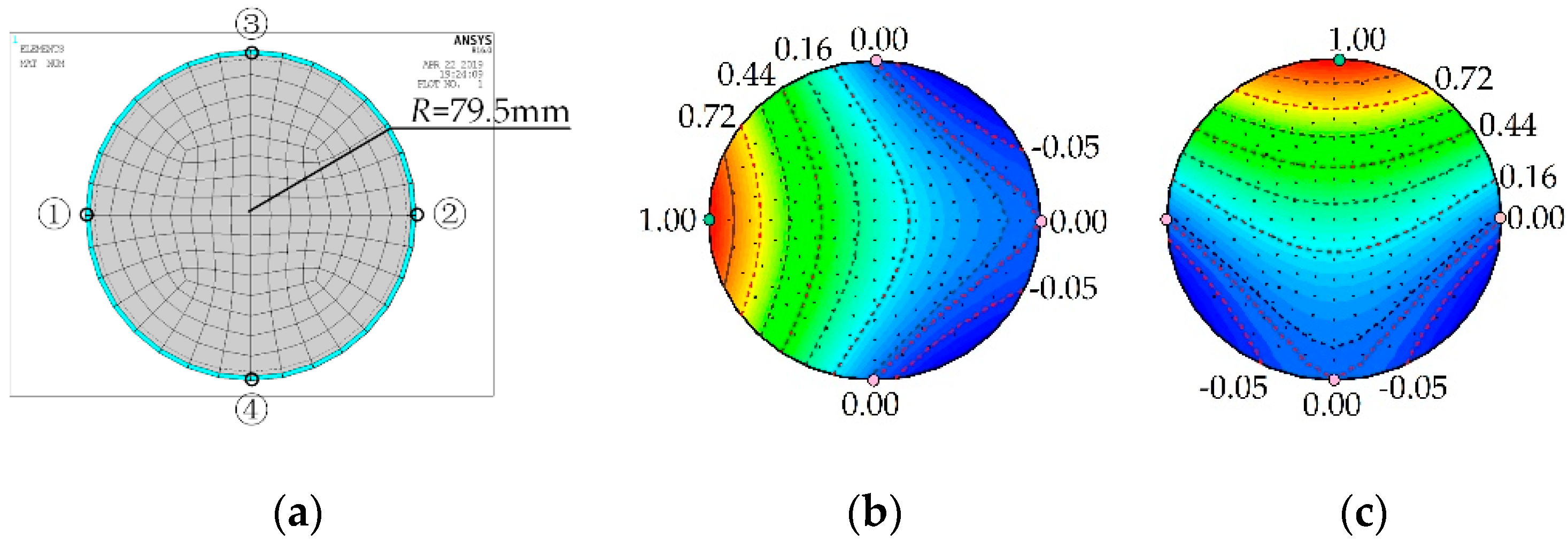


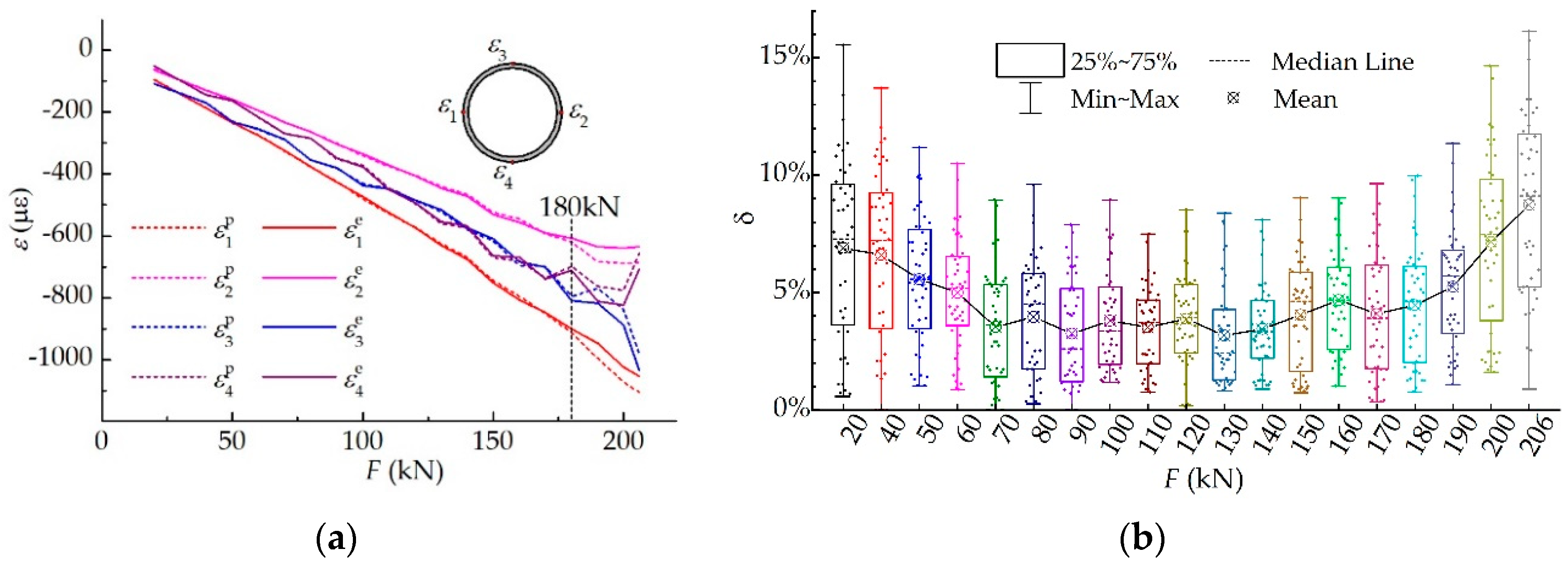
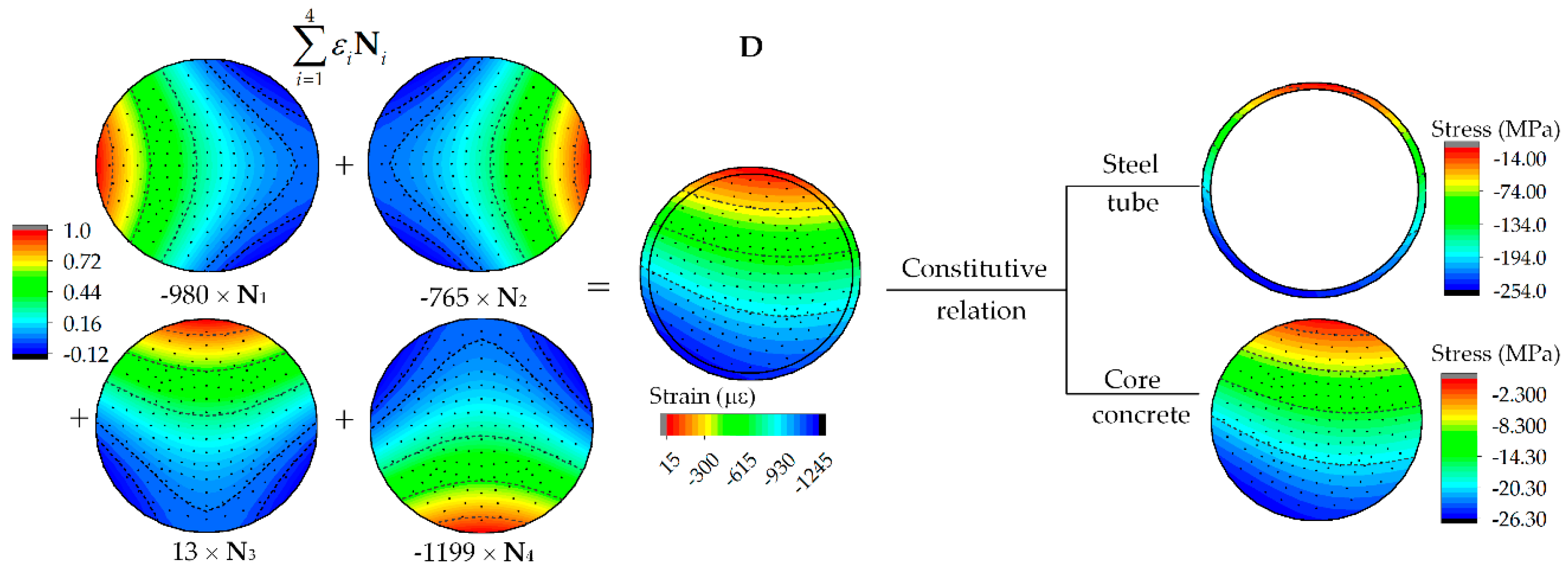
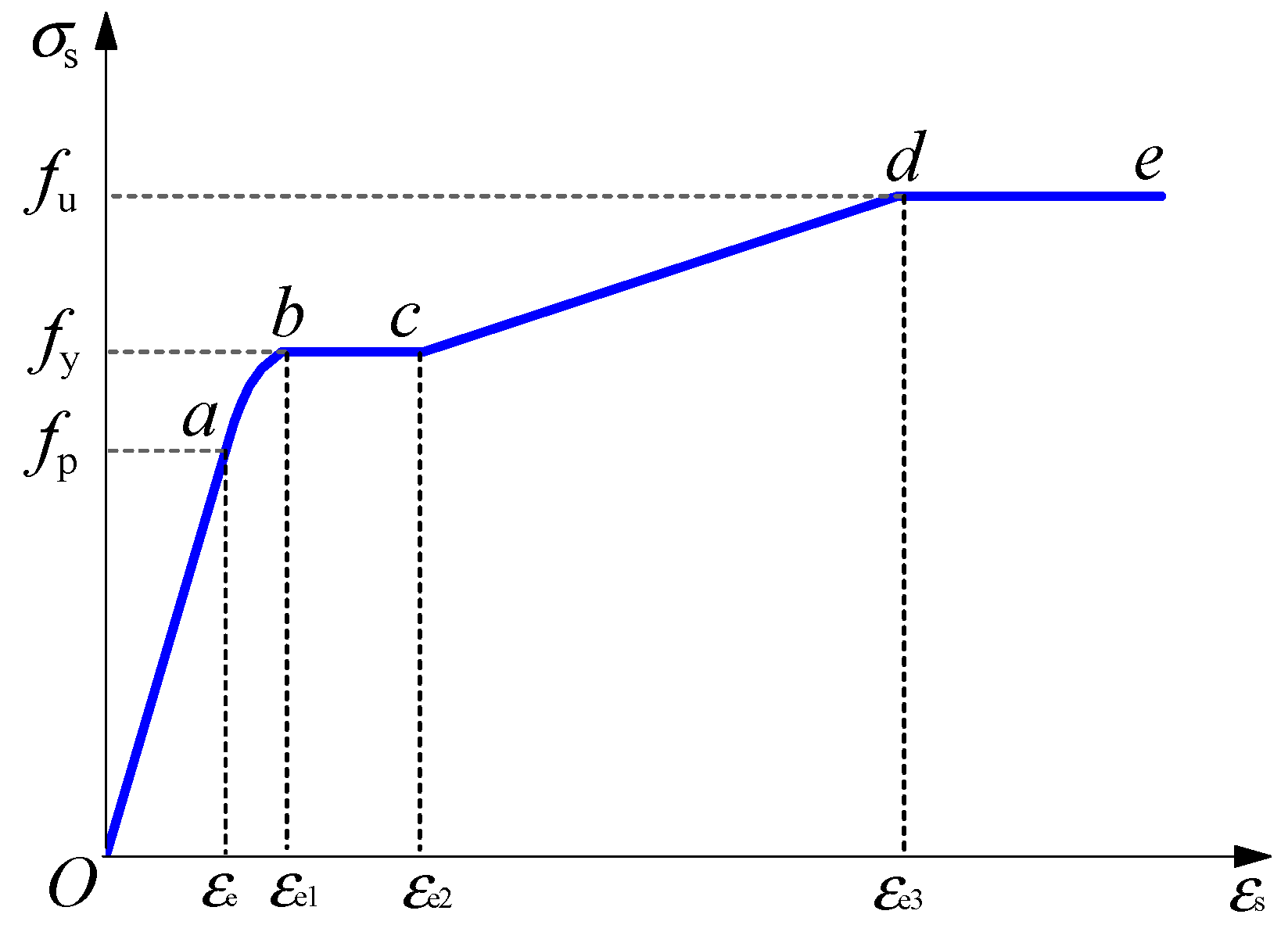
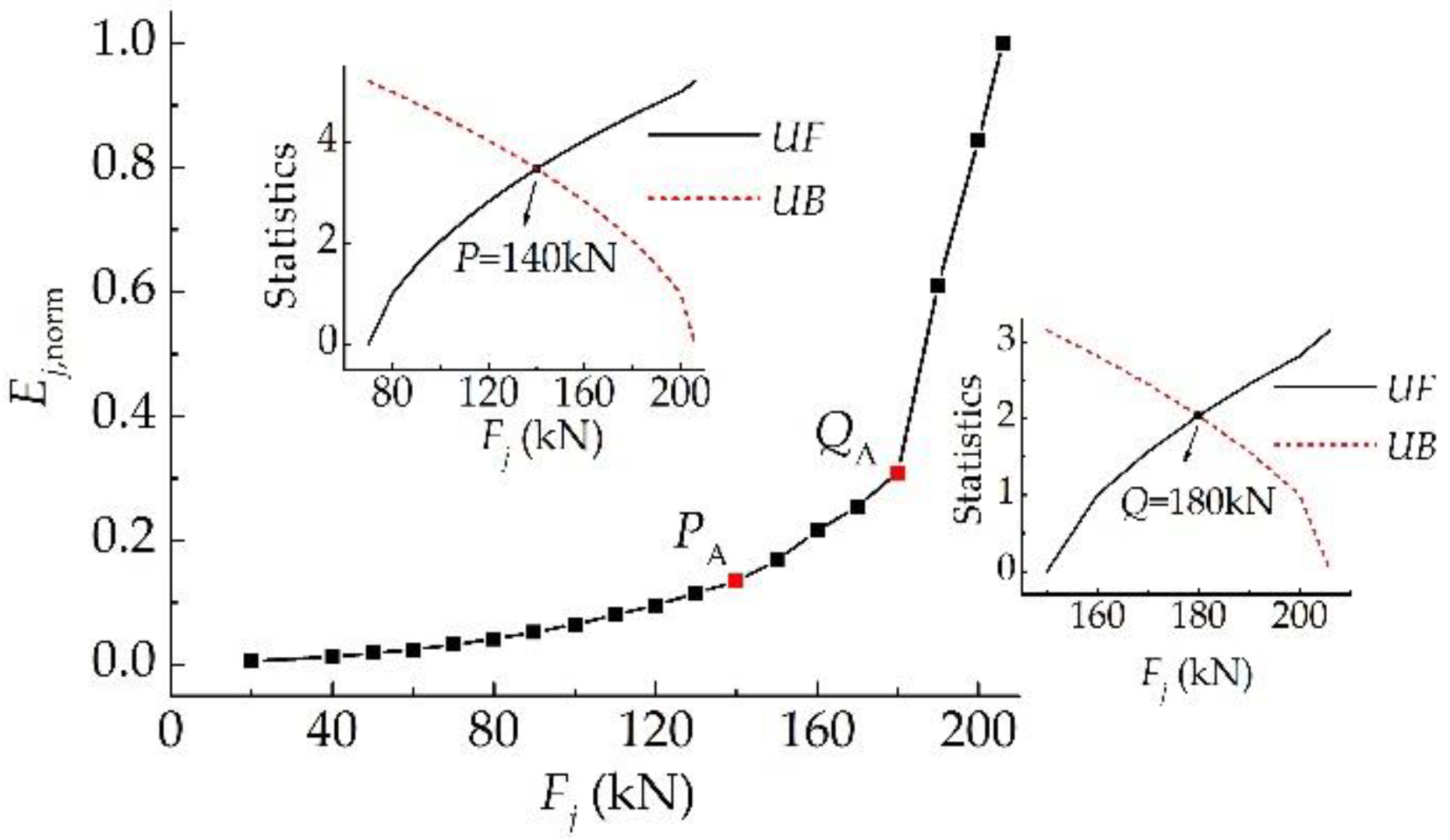
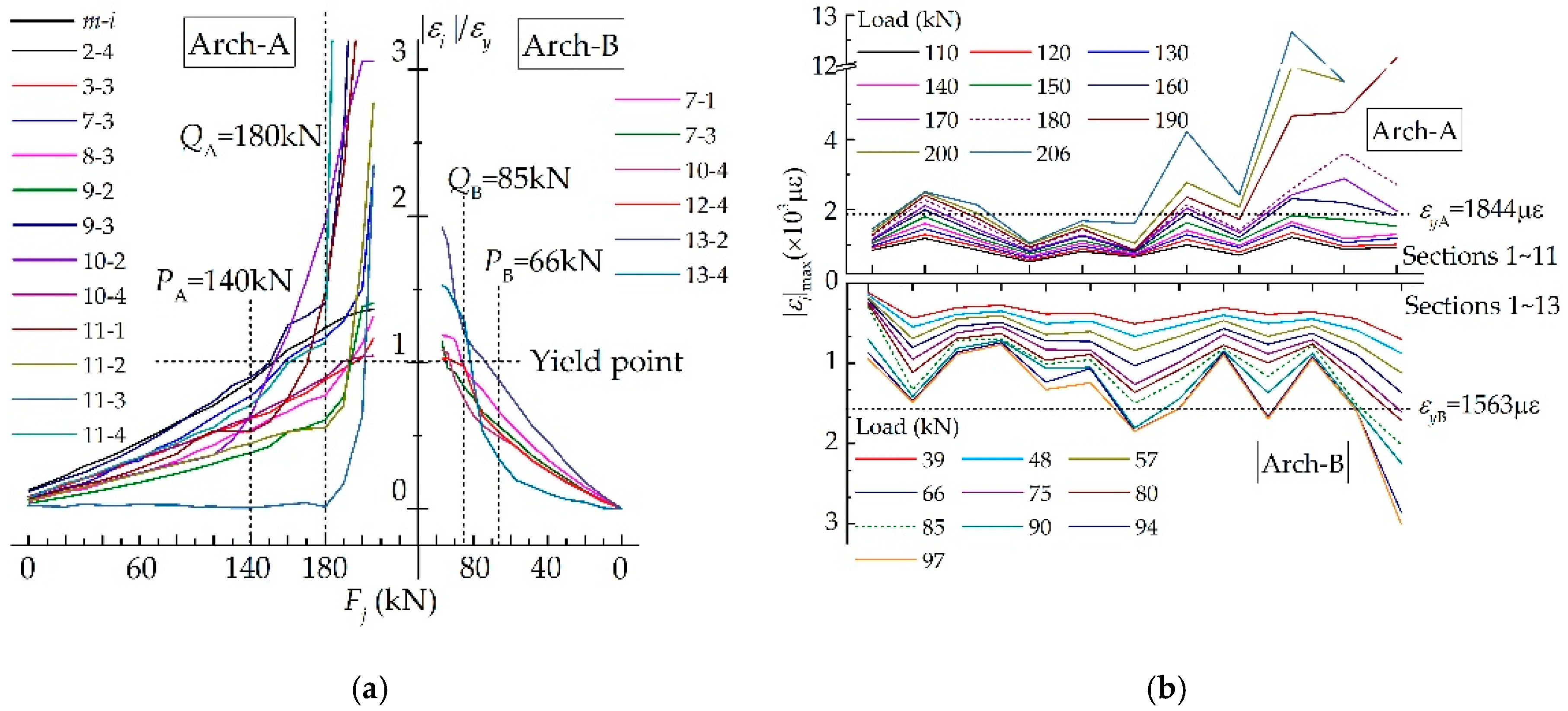

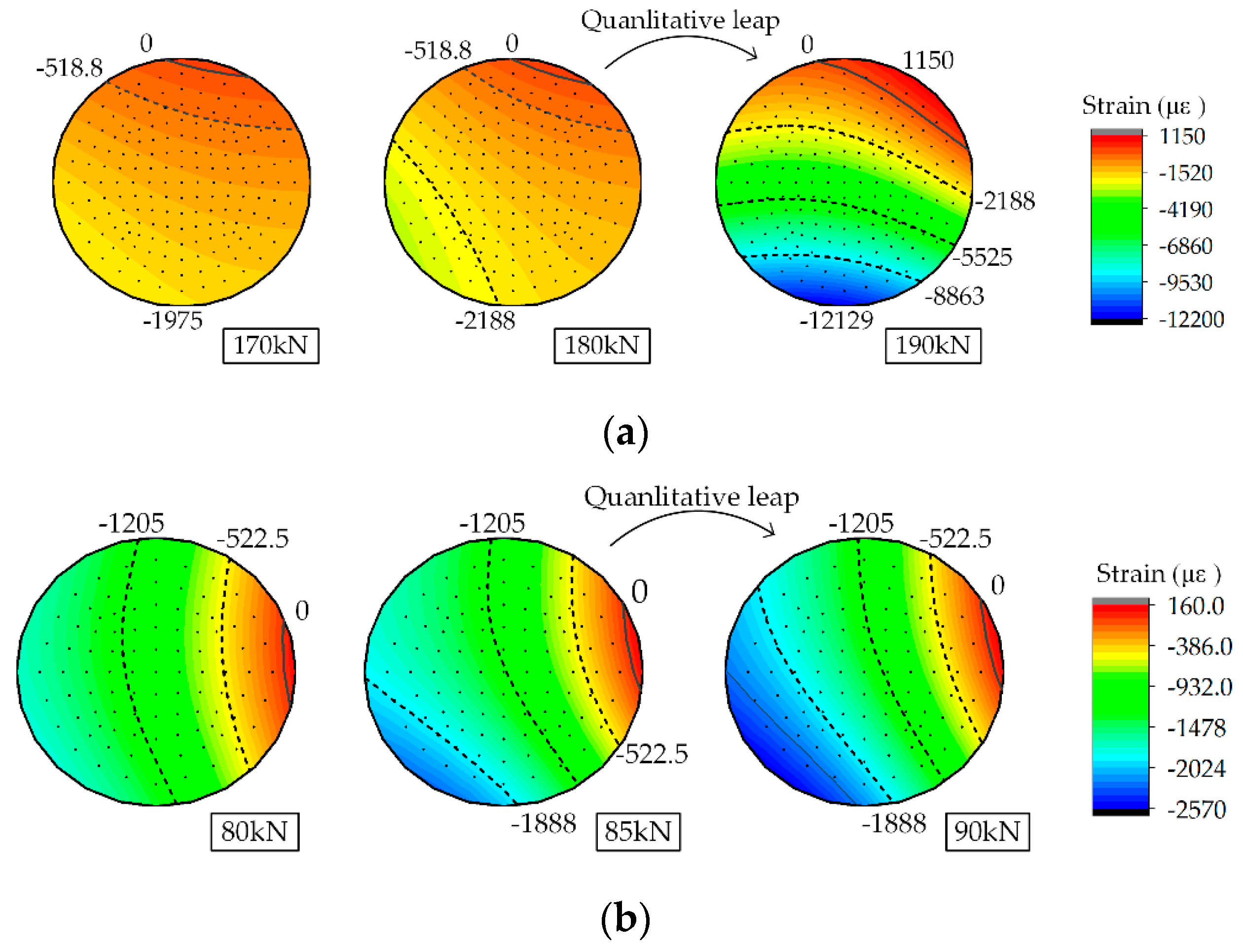
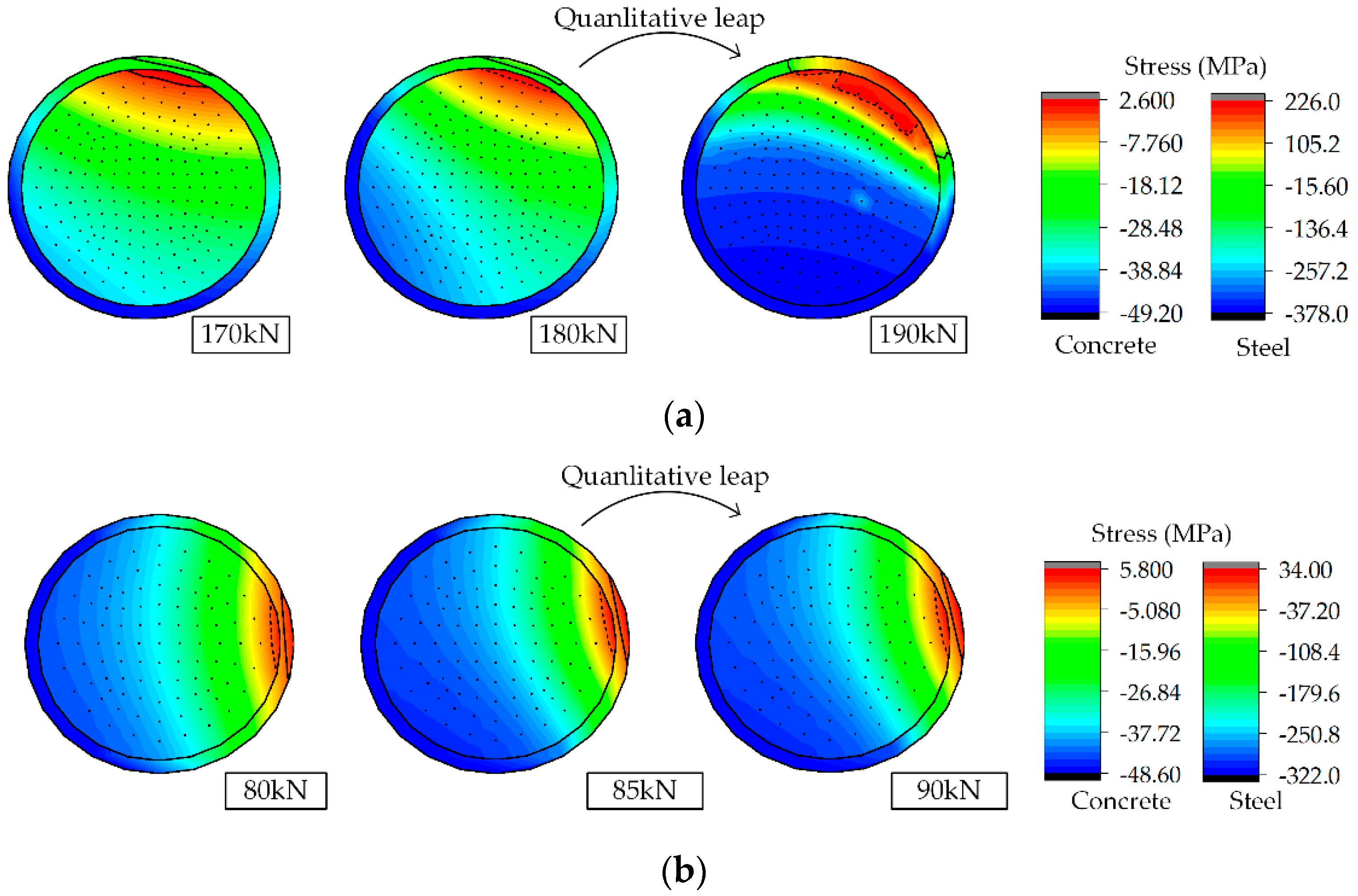
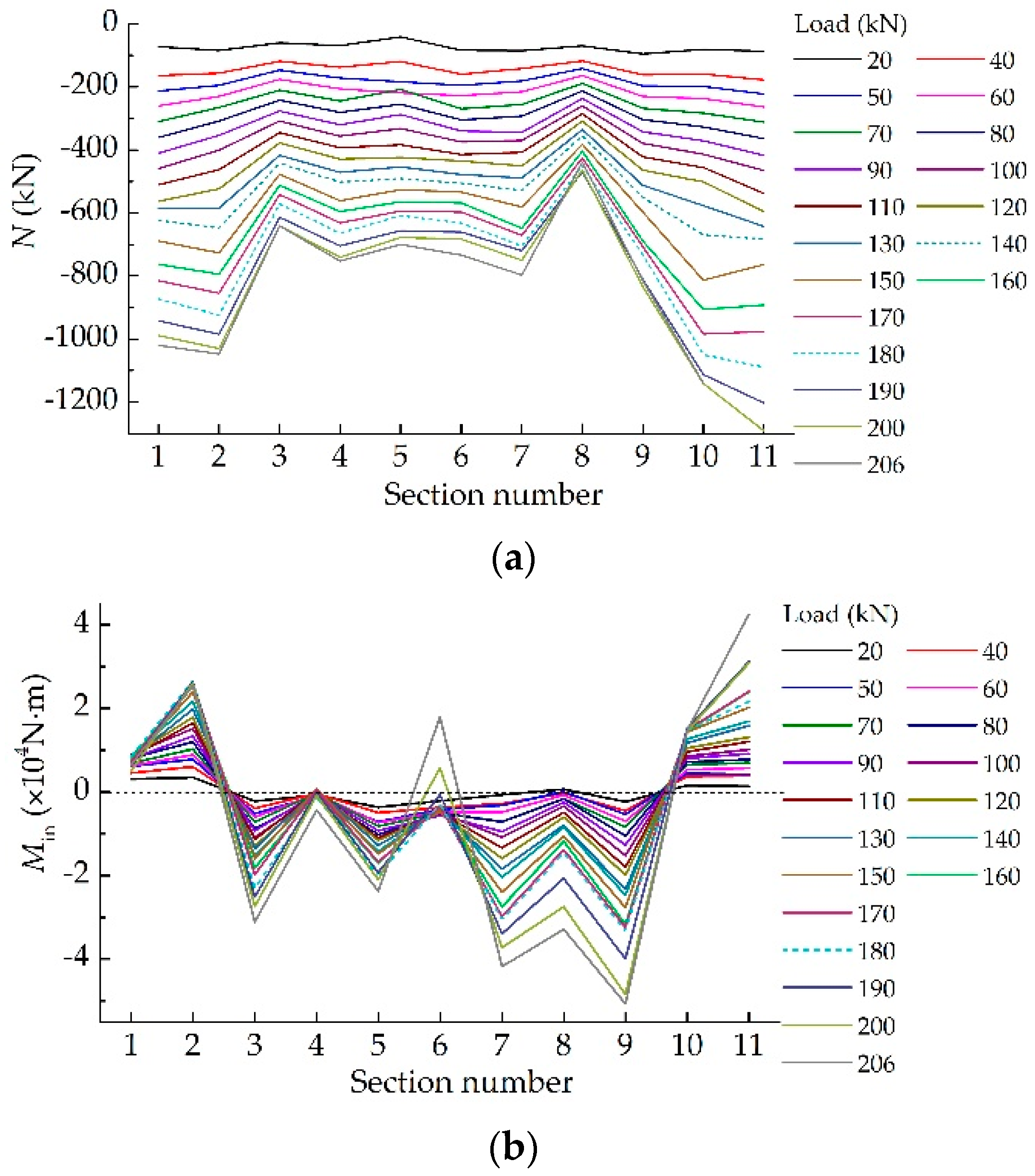
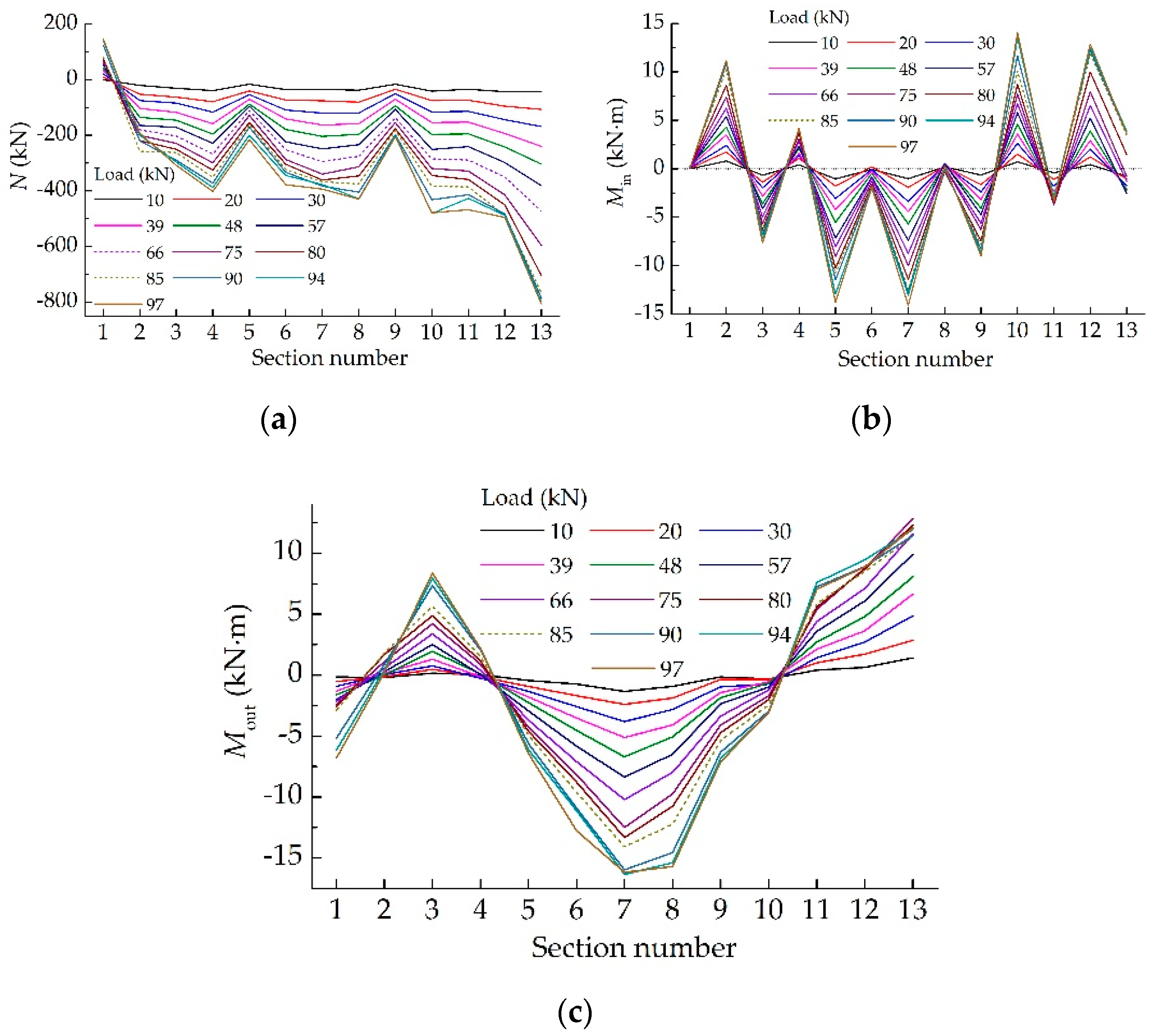
© 2019 by the authors. Licensee MDPI, Basel, Switzerland. This article is an open access article distributed under the terms and conditions of the Creative Commons Attribution (CC BY) license (http://creativecommons.org/licenses/by/4.0/).
Share and Cite
Yang, K.; Wang, W.; Shi, J.; Sun, G.; Zheng, K.; Zhang, M. Investigation on Single Tube CFST Arch Models by Modeling Structural Stressing State Based on NSF Method. Appl. Sci. 2019, 9, 5006. https://doi.org/10.3390/app9235006
Yang K, Wang W, Shi J, Sun G, Zheng K, Zhang M. Investigation on Single Tube CFST Arch Models by Modeling Structural Stressing State Based on NSF Method. Applied Sciences. 2019; 9(23):5006. https://doi.org/10.3390/app9235006
Chicago/Turabian StyleYang, Kangkang, Wei Wang, Jun Shi, Guorui Sun, Kaikai Zheng, and Mingyue Zhang. 2019. "Investigation on Single Tube CFST Arch Models by Modeling Structural Stressing State Based on NSF Method" Applied Sciences 9, no. 23: 5006. https://doi.org/10.3390/app9235006
APA StyleYang, K., Wang, W., Shi, J., Sun, G., Zheng, K., & Zhang, M. (2019). Investigation on Single Tube CFST Arch Models by Modeling Structural Stressing State Based on NSF Method. Applied Sciences, 9(23), 5006. https://doi.org/10.3390/app9235006



